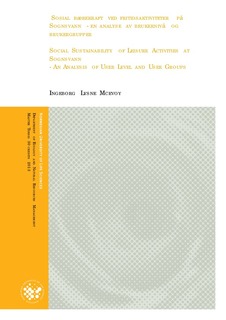| dc.description.abstract | Hensikten med denne masteroppgaven har vært å se på den sosiale bærekraften langs veien rundt Sognsvann i Oslo kommune. Dette har jeg gjort ved å se på de besøkendes sin toleranse for andre besøkende sitt nærvær og deres aktiviteter. Problemstillingen ble delt inn i fire hvor jeg (1) undersøkte hvem som bruker veien langs Sognsvann på fritiden, (2) kartla toleransen for brukernivået langs veien rundt Sognsvann (3) undersøkte hvor tolerante de besøkende er for ulike typer brukere og til slutt (4) så om det det er en sammenheng mellom brukernivå og toleranse.
Det ble brukt to ulike metoder for datainnsamling. Ferdselstellere med infrarød sensor registrerte antall passerende langs veien rundt Sognsvann, mens spørreskjema som var plassert i 3 svarkasser på ett plasseringspunkt sikret en utdypning av respondentenes toleranse for trengsel og ulike brukergrupper sine aktiviteter. Data fra begge datainnsamlingsmetodene ble koblet sammen ved bruk av dato og klokkeslett for registrering. I alt ble det registrert 2416 svarkort, men på grunn av aldersgrensen på 16 år ble kun 2318 svarkort tatt med videre i analysen. Det ble gjennomført en bortfallsanalyse for å avsløre eventuelle skjevheter i analysen av resultatene.
Resultatene viser at de fleste av respondentene fra spørreundersøkelsen har en relativt høy toleranse for brukernivået langs Sognsvann. De som bruker området er stort sett oppvokst og bosatt i Oslo og har dermed et godt grunnlag for å ha erfaring med området. Dette kan spille inn på graden av aksept for brukernivået i form av at de som besøker området vet hva de må forvente ved besøk om sommeren. Når det gjelder brukergrupper og aksept for ulike typer brukergrupper viser resultatene av respondentene er negativ til sykling (som er forbudt på veien rundt Sognsvann) og løpegrupper spesielt. Analyser av resultatene fra datainnsamlingsmetodene viser at jo høyere brukerintensiteten er, jo mer negativ er respondentene til de som løper eller jogger, de som har hunden løs på tur samt grupper med mer enn 5 mennesker. Abstract:
The purpose of this thesis has been to look at the social sustainability along the way around Sognsvann in Oslo. I have been looking at the visitor's tolerance for other visitors presence and their activities. The questions that were raised were divided into four where I looked at (1) who are using the road along Sognsvann during their spare time, (2) what are the tolerance for user level along Sognsvann, (3) how tolerant are the visitors for different types of users, and finally (4) if there is a correlation between user level and tolerance.
Two different methods of data collection were used. Traffic counters with infrared sensors recorded the number of passings along the road around Sognsvann, while the questionnaire was placed in three response boxes at one location point which secured an elaboration of the respondents' tolerance of crowding and different user's activities. Data from both collection methods were linked together using the date and time of registration. In all, there were registered 2416 response cards, but because of the age limit of 16 years there were only 2,318 response cards included further in the analysis. It was conducted a lapse analysis to reveal any bias in the analysis of the results.
The results show that the majority of respondents to the survey have a relatively high tolerance for the user level along Sognsvann. Those who use the area are mostly raised and lives in Oslo and thus a good basis for having experience in the area. This can record the degree of acceptance for the user level in terms of those who visit the area know what to expect when visiting in the summer. When it comes to consumer and acceptance of various types of user groups, the results of the respondents are negative to cycling (which is forbidden on the road around Sognsvann) and running groups in particular. Analysis of the results from both of the data collection methods show that the higher use intensity, the more negative the respondents to the running or jogging , those who let their dogs run free, as well as groups with more than 5 people. | no_NO |
